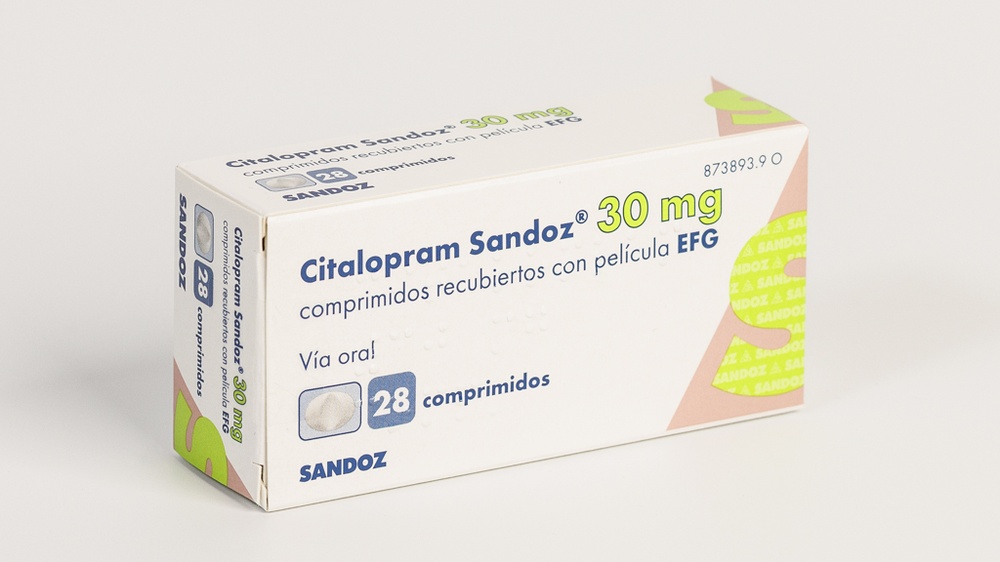

CITALOPRAM SANDOZ 30 mg COMPRIMIDOS REVESTIDOS POR PELÍCULA

Pergunte a um médico sobre a prescrição de CITALOPRAM SANDOZ 30 mg COMPRIMIDOS REVESTIDOS POR PELÍCULA

Como usar CITALOPRAM SANDOZ 30 mg COMPRIMIDOS REVESTIDOS POR PELÍCULA
Introdução
Prospecto: informação para o utilizador
Citalopram Sandoz 20 mg comprimidos revestidos com película EFG
Citalopram Sandoz 30 mg comprimidos revestidos com película EFG
Leia todo o prospecto atentamente antes de começar a tomar este medicamento,porque contém informações importantes para si.
- Conserva este prospecto, porque pode ter que voltar a lê-lo.
- Se tiver alguma dúvida, consulte o seu médico ou farmacêutico.
- Este medicamento foi-lhe prescrito apenas para si, e não deve dá-lo a outras pessoas, mesmo que tenham os mesmos sintomas que si, porque pode prejudicá-las.
- Se experimentar efeitos adversos, consulte o seu médico ou farmacêutico, mesmo que se trate de efeitos adversos que não aparecem neste prospecto. Ver secção 4.
Conteúdo do prospecto:
- O que é Citalopram Sandoz e para que é utilizado.
- O que precisa saber antes de começar a tomar Citalopram Sandoz.
- Como tomar Citalopram Sandoz.
- Posíveis efeitos adversos.
- Conservação de Citalopram Sandoz.
- Conteúdo do envase e informações adicionais
1. O que é Citalopram Sandoz e para que é utilizado
Citalopram é um inibidor seletivo da recaptação de serotonina (ISRS) e pertence ao grupo de medicamentos conhecidos como antidepressivos. Estes medicamentos ajudam a corrigir certos desequilíbrios químicos no cérebro, que causam os sintomas da sua doença.
Citalopram está indicado no tratamento de:
- Depressão e prevenção de recaídas e recorrências.
- Transtorno de ansiedade com ou sem agorafobia.
- Transtorno obsessivo-compulsivo (TOC).
Seu médico, de todas as formas, pode prescrever-lhe citalopram para qualquer outro propósito. Pergunte ao seu médico se tiver alguma dúvida sobre por que lhe foi prescrito citalopram.
2. O que precisa saber antes de começar a tomar Citalopram Sandoz
Não tome Citalopram Sandoz
- Se é alérgico a citalopram ou a algum dos outros componentes deste medicamento (incluídos na secção 6),
- Se está tomando outros medicamentos que pertencem a um grupo chamado inibidores da monoaminooxidase (IMAO). Os IMAO incluem medicamentos como fenelzina, iproniazida, isocarboxazida, nialamida, tranilcipromina, selegilina (para o tratamento do Parkinson), moclobemida (para o tratamento da depressão) e linezolid (um antibiótico).
- Se padece desde o nascimento algum tipo de alteração do ritmo do coração ou sofreu algum episódio deste tipo (isso é observado com o eletrocardiograma, uma prova que serve para avaliar como funciona o coração).
- Se está tomando medicamentos porque padece alguma doença que altera o ritmo do coração.
- Se está tomando medicamentos que podem chegar a afetar o ritmo do coração.
- Consulte também a secção “Outros medicamentos e Citalopram Sandoz” que se encontra mais abaixo.
Mesmo que tenha terminado o tratamento com IMAOs, precisa esperar 2 semanas antes de iniciar o tratamento com citalopram.
Deve transcorrer um dia após ter tomado moclobemida.
Depois de terminar com citalopram, deve transcorrer uma semana antes de tomar qualquer IMAO.
Advertências e precauções
Consulte o seu médico ou farmacêutico antes de começar a tomar Citalopram Sandoz.
Por favor, informe ao seu médico se tem alguma outra condição ou doença, pois o seu médico pode ter que levá-la em consideração. Em particular, informe ao seu médico:
- Se tem episódios maníacos ou transtorno de ansiedade.
- Se padece insuficiência hepática ou renal. O seu médico pode precisar ajustar a dosagem.
- Se padece diabetes. O tratamento com citalopram pode alterar o controlo glicémico. Pode precisar de um ajuste da dosagem de insulina e/ou de hipoglicemiantes orais.
- Se padece epilepsia. O tratamento com citalopram deve ser suspenso se se apresentarem convulsões ou se se produzir um aumento na frequência das convulsões (ver também secção 4 "Posíveis efeitos adversos").
- Se tem antecedentes de alterações hemorrágicas, se desenvolve hematomas inusuais ou se está grávida (ver “Gravidez, lactação e fertilidade”).
- Se tem um nível diminuído de sódio no sangue.
- Se está a receber tratamento eletroconvulsivo.
- Se padece ou já padeceu algum problema de coração ou sofreu recentemente um infarto cardíaco.
- Se, quando está em repouso, o seu coração late devagar (isso é conhecido como bradicardia) e/ou acredita que o seu organismo pode estar a ter perdas de sal, por exemplo, porque teve diarreia e vómitos intensos durante vários dias ou porque usou diuréticos (medicamentos para urinar).
- Se notou que os latidos do seu coração são rápidos ou irregulares ou sofreu desmaios ou tonturas ao se levantar desde a posição de sentado ou deitado. Isso poderia indicar que tem alguma alteração do ritmo do coração.
- Se tem um problema com a dilatação das pupilas oculares (midriase).
Consulte o seu médico, mesmo que alguma das circunstâncias anteriormente mencionadas lhe tenha ocorrido alguma vez.
Alguns pacientes com doença maníaco-depressiva podem entrar em uma fase maníaca. Isso se caracteriza por uma mudança de ideias pouco comum e rápida, alegria desproporcionada e atividade física excessiva. Se você experimenta isso, contacte o seu médico.
Sintomas como inquietude ou dificuldade para sentar-se ou permanecer de pé (acatisia) também podem ocorrer durante as primeiras semanas do tratamento. Informe ao seu médico imediatamente se você experimenta esses sintomas.
Alguns medicamentos do grupo ao qual pertence citalopram (chamados ISRS/IRSN) podem causar sintomas de disfunção sexual (ver secção 4). Em alguns casos, esses sintomas persistem após a suspensão do tratamento.
Informação especial relacionada com a sua doença
Assim como outros medicamentos para o tratamento da depressão ou doenças relacionadas, a melhoria não se alcança imediatamente. Após iniciar o tratamento com citalopram, podem passar várias semanas antes de que você experimente alguma melhoria.
No tratamento do transtorno de ansiedade, normalmente, passam de 2 a 4 semanas antes de que se observe alguma melhoria.
No início do tratamento, alguns pacientes podem experimentar um aumento da ansiedade, que
desaparece com o tratamento de continuação. Portanto, é muito importante que siga exatamente as instruções do seu médico e não interrompa o tratamento ou altere a dosagem sem consultar o seu médico.
Pensamentos suicidas e piora da sua depressão ou transtorno de ansiedade
Se você se encontra deprimido e/ou sofre um transtorno de ansiedade, pode, em algumas ocasiões, ter pensamentos nos quais se faça mal ou se quite a vida. Esses podem ir aumentando ao tomar antidepressivos pela primeira vez, posto que todos esses medicamentos requerem um tempo para começar a fazer efeito, geralmente ao redor de duas semanas, embora em alguns casos pudesse ser maior o
tempo.
Você seria mais propenso a ter esse tipo de pensamentos:
- Se você previamente teve pensamentos nos quais se quite a vida ou se faça mal.
- Se você é um adulto jovem. Informação de ensaios clínicos demonstrou um aumento do risco de condutas suicidas em adultos jovens (menores de 25 anos) com doenças psiquiátricas que foram tratados com um antidepressivo.
Se, em qualquer momento, você tiver pensamentos nos quais se faça mal ou se quite a vida, contacte o seu médico ou dirija-se diretamente a um hospital.
Pode ser de ajuda para você dizer a um parente ou um amigo próximoque você está deprimido ou que tem um transtorno de ansiedade e pedir-lhe que leia este prospecto. Pode perguntar-lhes se acham que a sua depressão ou transtorno de ansiedade piorou, ou se estão preocupados com as mudanças na sua atitude.
Crianças e adolescentes
Citalopram não deve ser utilizado normalmente no tratamento de crianças e adolescentes
menores de 18 anos. Ao mesmo tempo, deve saber que, em pacientes menores de 18 anos, existe um maior risco de efeitos adversos, como tentativas de suicídio, ideias de suicídio e hostilidade (predominantemente agressão, comportamento de confrontação e irritação), quando ingerem esta classe de medicamentos.
Apesar disso, o médico pode prescrever citalopram a pacientes menores de 18 anos quando decidir o que é mais conveniente para o paciente. Se o seu médico lhe prescreveu citalopram e é um paciente menor de 18 anos e deseja discutir esta decisão, por favor, volte ao seu médico. Deve informar ao seu médico se algum dos sintomas indicados anteriormente progride ou experimenta complicações quando pacientes menores de 18 anos estão tomando este citalopram. Ao mesmo tempo, os efeitos a longo prazo, no que se refere à segurança, e relativos ao crescimento, à maturidade e ao desenvolvimento cognitivo e comportamental deste citalopram, nesta faixa etária, ainda não foram demonstrados.
Outros medicamentos e Citalopram Sandoz
Informe ao seu médico ou farmacêutico se está tomando, tomou recentemente ou pudesse ter que tomar qualquer outro medicamento.
Alguns medicamentos podem afetar a ação de outros e isso pode causar, às vezes, reações adversas graves.
Informe ao seu médico se está utilizando algum dos seguintes medicamentos:
- Inibidores não seletivos da monoaminooxidase (IMAOs) que contêm fenelzina, iproniazida, isocarboxazida, nialamida e tranilcipromina como substâncias ativas. Se tomou algum desses medicamentos, deve esperar 14 dias antes de começar a tomar citalopram. Ao finalizar o tratamento com citalopram, deve esperar 7 dias antes de tomar algum desses medicamentos.
- Inibidores seletivos reversíveis MAO-A que contêm moclobemida (para o tratamento da depressão).
- O antibiótico linezolid.
- Lítio (para profilaxia e tratamento do transtorno maníaco-depressivo) e triptófano.
- Imipramina e desipramina (para o tratamento da depressão).
- Inibidores irreversíveis MAO-B, que contêm selegilina (para o tratamento da doença de Parkinson); esses aumentam o risco de efeitos adversos. A dosagem de selegilina não deve exceder 10 mg ao dia.
- Metoprolol (para o tratamento da pressão sanguínea elevada e/ou doença cardíaca); os níveis sanguíneos de metoprolol se incrementam, mas não se observaram sinais do efeito aumentado ou efeitos adversos do metoprolol.
- Sumatriptano e medicamentos semelhantes (para o tratamento da enxaqueca) e opioides, como tramadol e buprenorfina (para o tratamento da dor grave), incrementam o risco de efeitos adversos; se tiver algum sintoma incomum utilizando esta combinação, deve ver o seu médico.
- Cimetidina, lansoprazol e omeprazol (utilizados para o tratamento das úlceras de estômago), fluconazol (utilizado para o tratamento de infecções por fungos), fluvoxamina (antidepressivo) e ticlopidina (utilizada para reduzir o risco de acidentes cerebrovasculares). Podem aumentar os níveis de citalopram no sangue, mas não se comunicou aumento dos efeitos adversos de citalopram.
- Medicamentos que afetam a função plaquetária (por exemplo, alguns medicamentos antipsicóticos, ácido acetilsalicílico (para o tratamento da dor), medicamentos anti-inflamatórios não esteroideos (para o tratamento da artrite); aumentam ligeiramente o risco de alterações hemorrágicas.
- Erva de S. João (Hypericum perforatum) (um remédio à base de plantas medicinais utilizado para a depressão); a administração concomitante com citalopram pode aumentar o risco de efeitos adversos.
- Mefloquina (para o tratamento da malária), bupropion (para tratamento da depressão) e tramadol (para o tratamento da dor grave) devido a um possível risco de diminuir o limiar para as convulsões.
- Neurolépticos (medicamentos para o tratamento da esquizofrenia, psicose), devido a um possível risco de diminuir o limiar para as convulsões, e antidepressivos.
- Antiarrítmicos classe IA e III, antipsicóticos (p. ex., derivados da fenotiazina, pimozida, haloperidol), antidepressivos tricíclicos, determinados medicamentos antimicrobianos (esparfloxacino, moxifloxacino, eritromicina IV, pentamidina, medicamentos contra a malária, particularmente halofantrina), certos antihistamínicos (astemizol, mizolastina).
- Medicamentos que diminuem os níveis de potássio ou magnésio no sangue, pois incrementam o risco de sofrer alterações do ritmo cardíaco, que supõem um risco para a vida. Não tome citalopram se está tomando medicamentos porque padece alguma doença que altera o ritmo do coração ou se está tomando medicamentos que, por si mesmos, pudessem chegar a afetar o ritmo do coração. Se tiver dúvidas sobre este tema, consulte o seu médico.
Toma de Citalopram Sandoz com alimentos, bebidas e álcool
Citalopram pode ser tomado com ou sem alimentos (ver secção 3. “Como tomar Citalopram Sandoz”).
Observou-se que citalopram não aumenta os efeitos do álcool. No entanto, é aconselhável evitar o consumo de álcool durante o tratamento com citalopram.
Gravidez, lactação e fertilidade
Se está grávida ou em período de lactação, acredita que possa estar grávida ou tem intenção de engravidar, consulte o seu médico ou farmacêutico antes de utilizar este medicamento.
As mulheres grávidas não devem normalmente tomar citalopram, nem as mães devem amamentar os seus bebês enquanto tomam este medicamento, a menos que o seu médico tenham analisado os riscos e benefícios envolvidos.
Se tomar citalopram durante os últimos 3 meses da sua gravidez e até a data do nascimento, seja consciente de que se podem observar no bebê recém-nascido os seguintes efeitos: dificuldade respiratória, pele azulada, ataques, mudanças da temperatura corporal, dificuldades para se alimentar, vômitos, açúcar baixo no sangue, rigidez ou flacidez muscular, reflexos intensos, tremores, inquietude, irritabilidade, letargia, choro constante, sonolência e dificuldades para adormecer. Se o seu bebê recém-nascido tiver algum desses sintomas, por favor, contacte o seu médico imediatamente.
Se tomar citalopram na etapa final da gravidez, pode produzir um maior risco de sangramento vaginal abundante pouco após o parto, especialmente se tiver antecedentes de alterações hemorrágicas. O seu médico ou parteira devem saber que você está tomando citalopram para poder aconselhá-la.
Citalopram passa para o leite materno em pequenas quantidades. Há risco de efeitos no filho. Se está tomando citalopram, informe o seu médico antes de iniciar a lactação.
Certifique-se de que a sua parteira e/ou médico estão informados de que está em tratamento com citalopram.
Durante a gravidez, particularmente nos últimos 3 meses, medicamentos como citalopram podem aumentar o risco de uma doença grave em recém-nascidos, denominada hipertensão pulmonar persistente neonatal (HPPN), na qual o bebê respira rapidamente e se torna azulado. Esses sintomas geralmente começam durante as primeiras 24 horas após o nascimento. Se aparecerem no seu bebê, deve contactar a sua parteira e/ou médico imediatamente.
Citalopram demonstrou reduzir a qualidade do esperma em modelos animais. Teoricamente, esse efeito poderia afetar a fertilidade, mas até a data não se observou seu impacto na fertilidade humana.
Condução e uso de máquinas
Geralmente, citalopram não causa sonolência; no entanto, se se sentir mareado ou dormido quando começar a tomar este medicamento, não conduza ou utilize ferramentas ou maquinaria até que esses efeitos desapareçam.
Citalopram Sandoz contém lactose e sódio
Se o seu médico lhe indicou que padece uma intolerância a certos açúcares, consulte com ele antes de tomar este medicamento.
Este medicamento contém menos de 1 mmol de sódio (23 mg) por comprimido revestido com película; isso é, essencialmente “isento de sódio”.
3. Como tomar Citalopram Sandoz
Siga exatamente as instruções de administração deste medicamento indicadas pelo seu médico. Em caso de dúvida, consulte novamente o seu médico ou farmacêutico.
Adultos
Depressão
A dose habitual é de 20 mg por dia. Se assim o considerar necessário, o seu médico poderá aumentar esta dose até atingir um máximo de 40 mg por dia.
Trastorno de ansiedade
A dose inicial é de 10 mg por dia durante a primeira semana antes de aumentá-la para 20 ou 30 mg por dia. O seu médico, se o considerar necessário, poderá aumentar esta dose até atingir um máximo de 40 mg por dia.
Trastorno obsessivo-compulsivo (TOC)
A dose inicial é de 20 mg por dia. O seu médico, se o considerar necessário, poderá aumentar esta dose até atingir um máximo de 40 mg por dia.
Idade avançada (maiores de 65 anos)
Nos pacientes de idade avançada, deve-se iniciar o tratamento com metade da dose recomendada, por exemplo, 10 ou 20 mg por dia.
Em termos gerais, os pacientes de idade avançada não devem tomar mais de 20 mg por dia.
Pacientes com riscos especiais
Os pacientes que tenham doenças do fígado não devem tomar mais de 20 mg por dia.
Uso em crianças e adolescentes
Citalopram não deve ser administrado a crianças ou adolescentes. Para informações adicionais, ver seção 2 “O que você precisa saber antes de começar a tomar Citalopram Sandoz”.
Como e quando tomar Citalopram Sandoz
Citalopram é tomado todos os dias como dose única diária.
Os comprimidos podem ser tomados a qualquer momento do dia, independentemente das refeições.
Os comprimidos devem ser engolidos com um copo de água. Não os mastigue (eles têm sabor amargo).
Duração do tratamento
Como outros medicamentos para a depressão, o trastorno de ansiedade e o trastorno obsessivo-compulsivo, podem passar algumas semanas antes de que você sinta alguma melhoria. Continue tomando citalopram mesmo que passe algum tempo antes de que você sinta alguma melhoria na sua doença.
Nunca modifique a dose do medicamento sem falar antes com o seu médico.
A duração do tratamento é individual, geralmente como mínimo 6 meses. Continue tomando os comprimidos durante o tempo recomendado pelo seu médico. Não deixe de tomá-los, mesmo que se sinta melhor, a menos que o seu médico o tenha indicado. A doença de base pode persistir durante um período longo e, se você interromper o tratamento muito cedo, os seus sintomas podem reaparecer.
Os pacientes com depressões recorrentes se beneficiam do tratamento de continuação, às vezes durante vários anos, para prevenir a ocorrência de novos episódios depressivos.
Se você tomar mais Citalopram Sandoz do que deve
Se você tomou mais Citalopram Sandoz do que deve, consulte imediatamente o seu médico, o seu farmacêutico ou ligue para o Serviço de Informação Toxicológica, telefone: 91 562 04 20, indicando o medicamento e a quantidade utilizada. Faça-o, mesmo que não observe desconfortos ou sinais de intoxicação. Leve o envase de Citalopram Sandoz com você ao médico ou ao hospital.
Alguns dos sintomas de uma sobredose podem incluir batimentos irregulares do coração com risco para a vida, convulsões, alterações no ritmo do coração, sonolência, coma, vômitos, tremores, diminuição da pressão sanguínea, aumento da pressão sanguínea, náuseas (sentir-se mareado), síndrome serotoninérgica (ver seção 4. “Efeitos adversos possíveis”), agitação, tontura, dilatação das pupilas, suor, pele azulada, hiperventilação (aumento do ritmo respiratório).
Se você esquecer de tomar Citalopram Sandoz
Se você esquecer de tomar uma dose, tome a próxima dose no horário habitual.
Não tome uma dose dupla para compensar as doses esquecidas.
Se você interromper o tratamento com Citalopram Sandoz
Não deixe de tomar Citalopram Sandoz até que o seu médico o diga. Quando tiver completado o tratamento, por lo geral se recomenda que a dose de citalopram seja reduzida gradualmente durante várias semanas.
A retirada brusca da medicação pode produzir alguns distúrbios leves ou transitórios, tais como tontura, sensação de formigamento, alterações do sono (sonhos intensos, pesadelos, incapacidade de dormir), sensação de ansiedade, dor de cabeça, sensação de tontura (náuseas), vômitos, suor, sensação de inquietude ou agitação, tremores, sentimento de confusão ou desorientação, sentimentos de emoção ou irritação, diarreia (fezes soltas), alterações visuais, pulso rápido ou palpitações.
Quando tiver terminado o período do tratamento, por lo geral se recomenda que a dose de citalopram seja reduzida gradualmente durante um par de semanas em vez de interrompida bruscamente.
Se você tiver alguma outra dúvida sobre o uso deste medicamento, pergunte ao seu médico ou farmacêutico.
4. Efeitos adversos possíveis
Como todos os medicamentos, este medicamento pode produzir efeitos adversos, embora nem todas as pessoas os sofram.
Os efeitos adversos geralmente desaparecem após algumas semanas de tratamento. Tenha em mente que muitos dos efeitos também podem ser sintomas da sua doença e, portanto, melhorarão quando você começar a se sentir melhor.
Alguns pacientes relataram os seguintes efeitos adversos graves. Se você tiver algum dos seguintes sintomas, deve deixar de tomar citalopram e ver o seu médico imediatamente.
- Febre alta, agitação, confusão, tremores e contrações repentinas de músculos; podem ser sinais de uma situação pouco comum denominada síndrome serotoninérgica que foi relatada com o uso combinado de antidepressivos.
- Se você notar inchaço da pele, língua, lábios ou face, ou tiver dificuldades respiratórias ou de degluição (reação alérgica).
- Sangramentos incomuns, incluindo sangramentos gastrointestinais.
Efeitos adversos raros, mas graves (podem afetar até 1 de cada 1.000 pacientes):
Se você tiver algum dos seguintes sintomas, deve deixar de tomar citalopram e procurar o seu médico imediatamente.
- Hiponatremia: nível baixo de sódio no sangue que pode produzir cansaço, confusão e contração muscular.
- Batimentos cardíacos rápidos e irregulares ou sensação de desmaio, pois podem ser sintomas de um problema grave do coração conhecido como torsades de pointes.
Os seguintes efeitos adversos são geralmente leves e normalmente desaparecem após alguns dias de tratamento. Por favor, seja consciente de que vários dos efeitos mencionados abaixo podem ser sintomas da sua doença e, portanto, melhorarão quando você começar a se sentir melhor.
Se os efeitos adversos forem incômodos ou durarem mais de alguns dias, consulte o seu médico.
A secura da boca aumenta o risco de cáries. Portanto, você deve escovar os dentes mais frequentemente do que o habitual.
Efeitos adversos muito frequentes (podem afetar mais de 1 de cada 10 pacientes):
- Tendência ao sono.
- Dificuldade para dormir.
- Aumento da sudorese.
- Secura da boca.
- Náuseas (sentir-se mareado).
- Cefaleia.
Efeitos adversos frequentes (podem afetar até 1 de cada 10 pacientes):
- Diminuição do apetite.
- Agitação.
- Diminuição da conduta sexual.
- Ansiedade.
- Nervosismo.
- Estado confusional.
- Sonhos anormais.
- Tremores.
- Formigamento ou entorpecimento de mãos ou pés.
- Tontura.
- Alteração da atenção.
- Zumbidos nos ouvidos (tinido).
- Bocejos.
- Diarreia.
- Vômitos.
- Prisão de ventre.
- Erupção.
- Dor muscular e articular.
- Os homens podem experimentar problemas com a ejaculação e ereção.
- As mulheres podem experimentar dificuldade para alcançar o orgasmo.
- Fadiga.
- Febre.
- Coceira na pele.
- Diminuição de peso.
Efeitos adversos pouco frequentes (podem afetar até 1 de cada 100 pacientes):
- Distúrbios hemorrágicos cutâneos (aparição de hematomas com facilidade).
- Aumento do apetite.
- Agresividade.
- Despersonalização.
- Alucinações.
- Mania.
- Desmaios.
- Pupilas dilatadas.
- Batimentos cardíacos rápidos.
- Batimentos cardíacos lentos.
- Urticária.
- Perda de cabelo.
- Erupção cutânea.
- Sensibilidade à luz.
- Dificuldades para urinar.
- Hemorragia menstrual excessiva.
- Inchaço de braços e pernas.
- Aumento de peso.
Efeitos adversos raros (podem afetar até 1 de cada 1.000 pacientes):
- Convulsões.
- Movimentos involuntários.
- Alterações do paladar.
- Sangramento.
- Hepatite.
- Febre.
Frequência não conhecida (não pode ser estimada a partir dos dados disponíveis):
- Pensamentos de se fazer mal a si mesmo ou pensamentos de se matar, ver também a seção "Advertências e precauções".
- Redução de plaquetas no sangue, que aumenta o risco de sangramento ou cardenais (hematoma).
- Hipersensibilidade (erupção cutânea).
- Reação alérgica grave que provoca dificuldade para respirar ou tontura.
- Aumento da quantidade de urina excretada.
- Hipocaliemia: nível baixo de potássio no sangue que pode produzir fraqueza muscular, contrações ou ritmo anormal do coração.
- Crise de ansiedade.
- Rangido de dentes.
- Inquietude.
- Movimentos musculares anormais ou rigidez.
- Acatisia (movimentos involuntários dos músculos).
- Alterações da visão.
- Pressão sanguínea baixa.
- Sangramento nasal.
- Distúrbios hemorrágicos, incluindo sangramento de pele e mucosas (equimose).
- Inchaço súbito da pele ou mucosas.
- Ereções dolorosas.
- Aumento dos níveis de hormona prolactina no sangue.
- Fluxo de leite em homens e em mulheres que não estão em período de amamentação.
- Período menstrual irregular.
- Sangramento vaginal abundante pouco após o parto (hemorragia pós-parto), ver “Gravidez, amamentação e fertilidade” na seção 2 para mais informações.
- Testes de função hepática alterados.
- Hipotensão ortostática (queda importante da tensão arterial que se produz quando um indivíduo se põe de pé).
- Foi observado um aumento do risco de fraturas ósseas em pacientes tratados com este tipo de medicamentos.
- Ritmo cardíaco anormal.
Se você experimentar efeitos adversos, consulte o seu médico ou farmacêutico, mesmo que se trate de efeitos adversos que não aparecem neste prospecto.
Comunicação de efeitos adversos
Se você experimentar qualquer tipo de efeito adverso, consulte o seu médico ou farmacêutico, mesmo que se trate de possíveis efeitos adversos que não aparecem neste prospecto. Você também pode relatá-los diretamente através do Sistema Espanhol de Farmacovigilância de medicamentos de uso humano: https://www.notificaram.es. Mediante a comunicação de efeitos adversos, você pode contribuir para fornecer mais informações sobre a segurança deste medicamento.
5. Conservação de Citalopram Sandoz
Mantenha este medicamento fora da vista e do alcance das crianças.
Não requer condições especiais de conservação.
Não use este medicamento após a data de validade que aparece no envase após CAD/EXP. A data de validade é o último dia do mês que se indica.
Os medicamentos não devem ser jogados nos esgotos ou na lixeira. Deposite os envases e os medicamentos que não precisa no Ponto SIGRE da farmácia. Em caso de dúvida, pergunte ao seu farmacêutico como se livrar dos envases e dos medicamentos que não precisa. Dessa forma, você ajudará a proteger o meio ambiente.
6. Conteúdo do envase e informações adicionais
Composição de Citalopram Sandoz 20 mg comprimidos revestidos com película:
- O princípio ativo é citalopram. Cada comprimido contém 24,99 mg de citalopram hidrobromuro (equivalente a 20 mg de citalopram).
Os demais componentes (excipientes) são: amido de milho, lactose monohidrato, povidona K64, glicerol 85% (E-422), celulose microcristalina, estearato de magnésio, carboximetilamido sódico (tipo A) (proveniente de amido de batata), hipromelosa, dióxido de titânio (E 171), macrogol 6000 e talco.
Composição de Citalopram Sandoz 30 mg comprimidos revestidos com película
- O princípio ativo é citalopram. Cada comprimido contém 37,48 mg de citalopram hidrobromuro (equivalente a 30 mg de citalopram).
- Os demais componentes (excipientes) são: amido de milho, lactose monohidrato, povidona K64, glicerol 85% (E-422), celulose microcristalina, estearato de magnésio, carboximetilamido sódico (tipo A) (proveniente de amido de batata), hipromelosa, dióxido de titânio (E 171), macrogol 6000 e talco.
Aspecto do produto e conteúdo do envase
Citalopram Sandoz 20 mg são comprimidos revestidos com película, brancos, oblongos, biconvexos, ranurados por uma das faces e marcados com “C20” pela outra. São acondicionados em blisters de PVC/Alumínio ou em Alumínio/PVC/PVDC dentro de envases de 14, 28 ou 56 comprimidos.
Citalopram Sandoz 30 mg são comprimidos revestidos com película, brancos, oblongos, biconvexos, ranurados por uma das faces e marcados com “C30” pela outra.
São acondicionados em blisters de PVC/Alumínio ou em Alumínio/PVC/PVDC dentro de envases de 28 ou 56 comprimidos.
Pode ser que apenas alguns tamanhos de envases sejam comercializados.
Titular da autorização de comercialização e responsável pela fabricação
Titular da autorização de comercialização
Sandoz Farmacêutica, S.A.
Centro Empresarial Parque Norte
Edifício Roble
C/ Serrano Galvache, 56
28033 Madrid
Espanha
Responsável pela fabricação
Salutas Pharma GmbH
Otto-von-Guericke Allee 1
Barleben 39179
Alemanha
LEK, S.A.
Ul Domaniewska 50 C,
Varsóvia, PL 02-672
Polônia
Data da última revisão deste prospecto: julho 2024
A informação detalhada deste medicamento está disponível na página web da Agência Espanhola de Medicamentos e Produtos Sanitários (AEMPS) http://www.aemps.gob.es/

Quanto custa o CITALOPRAM SANDOZ 30 mg COMPRIMIDOS REVESTIDOS POR PELÍCULA em Espanha em 2025?
O preço médio do CITALOPRAM SANDOZ 30 mg COMPRIMIDOS REVESTIDOS POR PELÍCULA em novembro de 2025 é de cerca de 7.68 EUR. Os valores podem variar consoante a região, a farmácia e a necessidade de receita. Confirme sempre com uma farmácia local ou fonte online para obter informações atualizadas.
- País de registo
- Preço médio em farmácia7.68 EUR
- Substância ativa
- Requer receita médicaSim
- Fabricante
- Esta informação é apenas para referência e não constitui aconselhamento médico. Consulte sempre um médico antes de tomar qualquer medicamento. A Oladoctor não se responsabiliza por decisões médicas baseadas neste conteúdo.
- Alternativas a CITALOPRAM SANDOZ 30 mg COMPRIMIDOS REVESTIDOS POR PELÍCULAForma farmacêutica: COMPRIMIDO, 20 mgSubstância ativa: citalopramFabricante: Laboratorios Alter S.A.Requer receita médicaForma farmacêutica: COMPRIMIDO, 30 mgSubstância ativa: citalopramFabricante: Laboratorios Alter S.A.Requer receita médicaForma farmacêutica: COMPRIMIDO, 10 mgSubstância ativa: citalopramFabricante: Aristo Pharma GmbhRequer receita médica
Alternativas a CITALOPRAM SANDOZ 30 mg COMPRIMIDOS REVESTIDOS POR PELÍCULA noutros países
As melhores alternativas com o mesmo princípio ativo e efeito terapêutico.
Alternativa a CITALOPRAM SANDOZ 30 mg COMPRIMIDOS REVESTIDOS POR PELÍCULA em Polónia
Alternativa a CITALOPRAM SANDOZ 30 mg COMPRIMIDOS REVESTIDOS POR PELÍCULA em Ukraine
Médicos online para CITALOPRAM SANDOZ 30 mg COMPRIMIDOS REVESTIDOS POR PELÍCULA
Avaliação de posologia, efeitos secundários, interações, contraindicações e renovação da receita de CITALOPRAM SANDOZ 30 mg COMPRIMIDOS REVESTIDOS POR PELÍCULA – sujeita a avaliação médica e regras locais.











